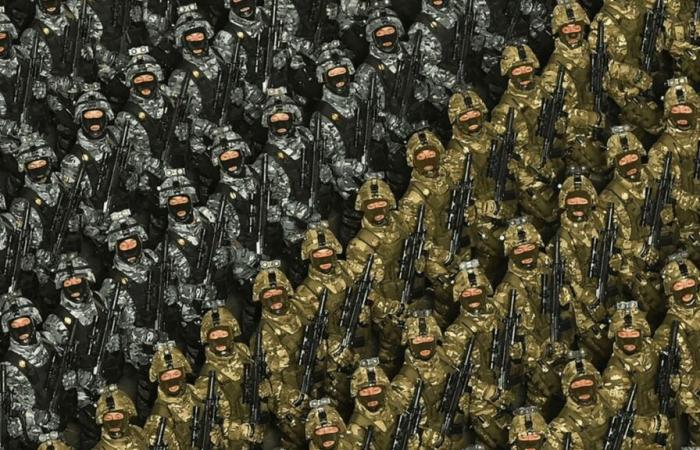For the first time, North Koreans were targeted by Ukrainian fire. This incident highlights a worrying development: North Korea is now a party to the conflict. What are the repercussions for the Kursk region?
Simon Cleven / t-online
More from “International”
An article from
The first rumors circulated in July 2024. South Korean media then reported that a group of engineers from the neighboring country were going to the Ukrainian city of Donetsk, under Russian occupation, to help with reconstruction. Two months later, the new head of the Russian Security Council and former Defense Minister, Sergei Shoigu, met with Kim Jong-un.
Then everything happened very quickly.
In early October, Ukrainian intelligence sources reported the deaths of six North Korean officers in an attack near Donetsk, information confirmed by the South Korean government. In the following weeks, announcements multiplied: troops from Pyongyang would have been trained in Russia with a view to deployment on the border with Ukraine. Last week, US Secretary of State Antony Blinken declared that their engagement against Ukrainian troops was imminent.
Andrij Kovalenko heads the Center for Combating Disinformation of the National Security and Defense Council of Ukraine. He communicated Monday on Telegram:
“The first servicemen of the Democratic People’s Republic of Korea (DPRK) are under enemy fire in the Kursk region.”
This announcement marks a turning point in the conflict.
At least 10,000 soldiers in Kursk
This information nevertheless remains difficult to control: did the Ukrainian army attack Russian positions in Kursk where North Koreans were stationed? Were they involved in an attack on Ukrainians? Did both sides suffer losses? The answers are lacking.
Basically, North Korean soldiers would be supposed to support the Russian counter-offensive in the region. In August, Ukrainians entered the border area, temporarily controlling more than 1,000 square kilometers of Russian territory. Moscow’s response has been a long time coming, but has been underway for several weeks, now with the support of Kim Jong-un’s troops. According to the United States, at least 10,000 reinforcements are already stationed in Kursk; Ukraine estimates this figure at 11,000, and more units could still arrive.
For Marko Milanovic, professor of international law at the British University of Reading, North Korea is no longer just an accomplice and is becoming a stakeholder in itself. Especially if it maintains control over its soldiers on Russian territory.
Meeting with the Minister of Foreign Affairs
Moscow and its ally strengthened their cooperation on Monday during a meeting between the North Korean foreign minister and the Russian president. He greeted Choe Son-hui, emphasizing that “meeting with friends on a holiday is a good tradition.” On November 4, Russia celebrates People’s Unity Day. The Kremlin did not provide details, but it appears that the minister conveyed Kim Jong-un’s greetings to her Russian counterpart.
It now remains to be known the scale and timetable of the engagement of North Korean troops against the Ukrainian forces. So far, only the Ukrainian statement on Monday morning has confirmed this. However, both kyiv and Washington believe that the situation could change very soon.
What impact on fighting in Kursk?
Will Moscow really benefit from the presence of Allied reinforcements? Russia has suffered heavy losses in recent months – with nearly 40,000 soldiers killed, wounded or missing in October, according to Estonian intelligence. Despite this, it maintains pressure on the adversary, particularly in Donbass, and seems to be making progress in Kursk.
In October, the Institute for the Study of War (ISW) claimed that Russia had reconquered approximately 46% of the territories taken by Ukraine in the Kursk region. But according to experts, these are mainly areas that are difficult for the Ukrainians to defend.
For Michael Bohnert, analyst at the Rand Corporation, Ukrainian troops are banking on efficiency: they are withdrawing from difficult positions while retaining more advantageous ones.
William Alberque, of the Stimson Center, emphasizes that recent Russian gains can be explained in part by the Ukrainian strategy of not defending territories that it does not intend to keep.
The Ukrainians are obviously trying to create a buffer zone, but also to cheer up faced with the prolonged absence of success on the battlefield. Their flexible tactics allow them to at least achieve the first of these two objectives.
Sending of additional armored vehicles
kyiv’s troops are now expected to receive significant support. According to the American magazine Forbes212 Stryker wheeled grenadier tanks are reportedly on the way as part of the US’ recently announced $425 million aid package. This would bring the Ukrainian arsenal contingent to nearly 400, despite previous losses on these vehicles.
The machines already delivered were used to equip two airborne brigades currently fighting in Kursk, continues Forbes. The new arrival could now be used to equip another brigade, also working in the area, but which does not have such infantry vehicles. Extremely mobile, they could considerably strengthen Ukrainian efforts in the Russian region.
However, we can wonder whether the invasion of Kursk will have a positive effect on the morale of the troops in the long term. From the start, the doubts of Ukrainian soldiers regarding this offensive were regularly raised: in fact, they are particularly under pressure in the Donbass. Russia has been making slow but steady progress there for months.
If the plan for the Kursk offensive was also to pin down Russian troops, it did not work. Instead, Russia further strengthened its offensive in eastern Ukraine.
Pertinence controversial
A Ukrainian soldier engaged in Kursk and known on X under the pseudonym “War Seeker” also wonders:
“It’s hard to understand the advantage of being here, when we are losing entire cities”
The North Koreans’ involvement could allow Russia to redeploy its troops in the Donbass, which would add additional pressure on Ukraine in this already fragile region.
The situation there remains worrying for kyiv. Last week, General Dmytro Marchenko spoke of a “fractured” front, although the worst has so far been avoided. The arrival of Asian reinforcements could pose new challenges to the Ukrainians, without giving a decisive advantage to the Kremlin army. Just the size of the units – larger – could complicate the task of Ukrainian soldiers on certain front lines.
Zelensky still hopes
kyiv’s allies, however, are worried and are talking about an escalation of the war. Even UN chief António Guterres, recently criticized for meeting with Putin, expressed concern. Volodymyr Zelensky once again calls on his partners to provide him with more weapons. But he also asks to be able to attack Russian soil with large-scale weapons that his army already has.
“We could strike upstream if we had the possibility and the capacity”
Volodymyr Zelensky
For this, he must still hope to obtain authorization from the United States, the United Kingdom or Germany.
All the hot news on Ukraine…
Show all articles
The war in Ukraine through the eyes of Alexander Chekmenev
1 / 25
The war in Ukraine through the eyes of Alexander Chekmenev
Faces of war pour le New York Times.
source: alexander chekmenev





